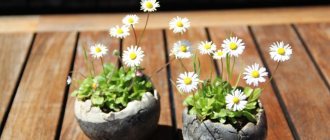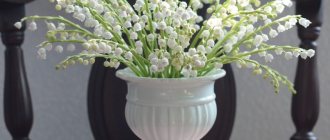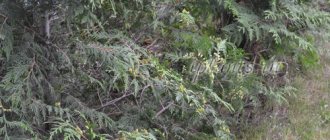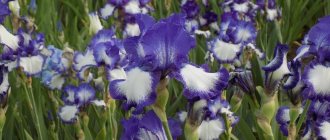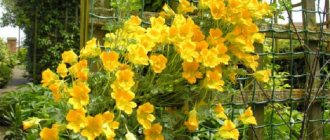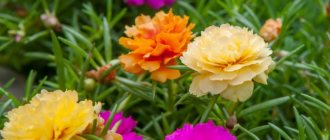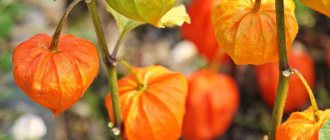Home » Flowers and plants » Flowers » Perennial flowers
Vladimir 03/19/2020
11192 Views 1 comment
Nasturtium is grown in the middle and northern latitudes of the country, having moved to us from South America. Flower culture feels wonderful here and fully demonstrates its decorative qualities. It is loved by Russian flower growers for its ease of care and large, bright flowers that peek out from under the round leaves. That is why the “foreign beauty” has become an inhabitant of most garden plots.
Biological characteristics: description
From South America, the bright flower came to Europe thanks to the Spanish conquistadors, who discovered it in the Mexican jungle and were amazed by the unusual plant. Scientist Nicholas Monard called it blood flower or Indian watercress.
And nasturtium received its real name thanks to the botanist Carl Linnaeus, who found it a specific place in his classification of plants. He figuratively compared the rounded leaves with the shields of warriors, and imagined the flowers as the bloody helmets of enemies, which in those days were hung on the columns of buildings.
Variegated nasturtiums
In Germany, the plant is known as capuchin because the calyx of the nasturtium resembles the hoods of Capuchin monks. So the name reflects both the peaceful life of people and periods of war.
Nasturtium or capuchin belongs to the herbaceous perennial crops of the a family of the same name . Since it does not tolerate cold climates, it is grown in the middle zone as an annual crop. The plant is most often creeping: tender and flexible shoots branch, forming numerous lashes up to 3-5 m long.
Rounded leaves of different shades of green on long petioles form smooth or wavy edges. They have a lobed, thyroid or palmate shape. Veins of a lighter color extend from the center to the edges, which gives the leaf additional decorativeness.
One of the climbing forms of nasturtium
They are framed by flowers, among which the predominant colors are from yellow to red with transitional forms. The flowers are large and reach 5 cm in diameter, located one at a time in the leaf axils. They are irregularly shaped with a spur, simple or terry.
In appearance, the flowers are similar to gramophones, the cups of which are formed by 5 petals, and in the center there are 5 stamens and a pistil, where the ovary is formed. The flowers have a pungent and somewhat distinctive aroma that attracts insect pollinators and, in the wild, hummingbirds.
The color of the shoots is directly related to the color of the leaf blade: if the flowers are red or purple, then the leaves are dark green, yellow flowers are combined with light green tones.
This is what capuchin seeds look like
The root system is taprooted with a few and underdeveloped lateral roots, which are located close to the surface and go to a depth of no more than 10-12 cm. Nasturtium produces large seeds up to 5-7 mm in diameter, formed from 3 parts. They are round, concave in shape with a light yellow shell and jagged edges. Separated along the entire length by longitudinal grooves.
The most common 2 garden forms: bush and climbing.
- The bush is characterized by an erect central shoot, from which shoots of the first order extend, located at an acute angle. The bush reaches 30 cm in height and is characterized by weak growth and close internodes, which gives the bush a compact shape.
- Climbing or creeping differs in that the main shoot is located on the ground and forms numerous lashes that extend from the main shoot at a right angle. Since the distances between internodes are large, the plant is very spreading and occupies a large area.
Story
Perhaps there is no such person who, after watching the famous film “The Man from the Boulevard des Capuchins,” did not think, what are Capuchins? It turns out that this word has several completely different concepts. Well, firstly, the “Boulevard of the Capuchins” or more correctly “Boulevard of the Capuchins” is one of the Grand Boulevards of Paris, named after the monastery that was once located on this street, in which female nuns from the “Capucin Order” lived. This boulevard became most famous after the opening of the first cinema on it in 1895, which became the most active promoter of cinema, one of whose emissaries was the hero of Andrei Mironov. By the way, members of the Capuchin Order got their name because an indispensable attribute of the monks’ attire were pointed hoods, which in Italy are called Capuchins. This is what is now called a masquerade costume consisting of a cloak with a pointed hood. Another meaning of this word is the name of the prehensile-tailed monkeys of South America.
Well, the most famous meaning of the word “capuchin” is the name of a flower, which in Latin is called Tropaeolum. The second Latin name for this flower was given by the creator of the classification system, Swedish physiologist Carl Linnaeus. He noticed the similarity of the leaves of this plant with the shields of ancient Roman soldiers, and the flowers themselves seemed very similar to the bloody helmets of defeated enemies, which were hung on columns in Rome in honor of victory. These columns were called tropaeolum. This name was not particularly popular and in most countries, including ours, this flower is called nasturtium.
Not only did nasturtium receive such amazing names, it has a rather unique history, as a result of which botanists recognized it as an ornamental species and it began to decorate our gardens.
When, in the 16th century, after Columbus's discovery of America, the Spanish conquistadors got deep into this continent, they noticed that in the mountainous regions, in the territory of present-day Peru, Chile, Bolivia, and Evador, local Indians ate tubers of some plants. One of which turned out to be potatoes. Europeans liked it and soon this culture was brought to Europe, where over time it received universal recognition. But the second plant, the tubers of which were eaten by the locals, was not liked by the newcomers from the “Old World”. It was tuberous nasturtium or mashua in other words. This plant is still cultivated in the Peruvian Andes and is used both as food and as animal feed. In those places you can find several varieties of wild nasturtium. The most famous are: curly nasturtium, Fintelmann's nasturtium, short-umbrella nasturtium. But a plant similar to it, blooming with red and yellow flowers, interested Europeans not because of its edible qualities, but because of the beauty of the flowers. Naturally, some of the Spaniards brought seeds of previously unseen plants to their homeland. Over time, the seeds of these plants spread throughout Europe.
A resident of Seville, Dr. Nicholas Monard, became interested in unknown plants brought from the New World. He purchased seeds from sailors and merchants returning from America and sowed them in his garden. And when from seeds unknown to him a plant grew that tasted like watercress, popular at that time, he, by analogy, began to call it nasturtium, which was the name given to many spicy plants with a tart smell. In his monograph published in 1571, Nicholas Monard gave this American plant the name "nasturtium". And although plant taxonomists subsequently discovered that this American nasturtium and watercress are completely different plants, the name given by Nicholas Monard stuck with it forever.
In general, plants of the nasturtium family have several dozen species. These are mainly ornamental species, but these flowering plants are also edible. But their main advantage, of course, is the amazing shape of the flowers and the beautiful color scheme. In addition, nasturtium flowers have an amazing ability: when the sun sets, they seem to flare up from within and glow themselves. This was first noticed by the daughter of Carl Linnaeus, which he did not believe at first until he saw it himself. This is how Rachinsky, a professor at Moscow University, described this phenomenon: “At sunset in the bright orange western sky, the flowers, which shone bright orange in such lighting, from time to time suddenly flared up even brighter and at that moment seemed completely fiery.” Nasturtium became widely used as a decoration for gardens only in the 16th century.
Types of nasturtium
Variety of shapes and colors of the “South American beauty”
Growing nasturtiums (Latin Tropaeolum) or capuchins became popular in the 50s of the last century. Its unpretentious bushes decorated parks, squares, squares, and garden plots. Not one of the “6 hundred square meters” was complete without beautiful orange “gramophones”. But about 10 years passed, and nasturtium was replaced by no less beautiful gardening plants. In European countries it is generally undeservedly forgotten.
Over the past years, breeders have created up to 90 species: a whole range of colors, colors and shades. Bush, ampelous, climbing, terry, and climbing specimens are known. But no more than 10 of the most common species are usually grown in garden plots.
Large or May nasturtium
May nasturtium: one of the varieties
Large or May nasturtium
- It is one of the most famous. Both erect and creeping varieties have been bred. Erect is a rounded bush up to 70 cm tall.
- The stems are fleshy and juicy, hollow inside. The leaves are located on long petioles and have different colors. A grayish coating with a purple tint forms on the underside.
- The flowers are yellow to bright red, double or semi-double, fragrant.
- With proper agricultural technology, flowering begins in June and continues until the end of September.
- Easily propagated by self-sowing.
- This species is represented by dozens of varieties.
Tuberous
Tuberous nasturtium as a fence design option
Tuberous
- It is distinguished by thin, climbing stems up to 2 m. The leaf blade is wide with rounded edges, the color is gray-green, on which light veins are clearly visible.
- It has a classic flower shape and a classic orange-red color scheme.
Cultural or hybrid
Small nasturtium
Cultivated or hybrid Cultivated or hybrid is considered the most numerous in terms of the number of varieties. Among them there are low-growing forms up to 30 cm in height, climbing ones, reaching 1 m, creeping ones with a fleshy stem up to 3 m, dwarf ones, growing only up to 15 cm.
Among this group the following stand out:
- Azure , a distinctive feature of which are unusual blue flowers. They are used in individual plantings and in flower beds.
- Tricolor has a contrasting combination of colors, which makes it a unique creation of breeders. It looks unusual as a separate plant and in any composition.
- Multileaf is not suitable for flower beds or ridges, but fits perfectly into the design of an alpine hill, since it has a variegated leaf blade and a small number of flowers.
Small is formed by thin stems that branch abundantly. The leaves are supported on delicate and long petioles and are small in size and thyroid-shaped. The flowers are small: they reach only 3 cm in diameter. The color of the flowers is yellow with dark spots inside. It blooms for a long time until frost.
Shield-bearing
Nasturtium shieldbearing
Cultural or hybrid
- Shield-bearing is a creeping shrub with dark green, fragile shoots.
- It grows up to 4 m. Between the dark green leaves there are burgundy flowers up to 6 cm in diameter, which creates a bright and unusual “floral ensemble”.
Foreign or Canarian
Nasturtium canary
Foreign or Canarian
- This is a climbing form that beautifully wraps around trellises and arbors, stretching up to 3.5 m.
- The leaves are medium-sized, five- or seven-parted. The flowers are yellow, corrugated, small. But due to their abundance, a variegated composition and yellow splashes are created.
Many varieties are unusual and highly decorative, but few even experienced gardeners can share their experience of growing such nasturtiums. Although they are not capricious, growing them requires certain skills.
Of the bush forms, the most interesting are: white “Snow Maiden”, crimson “Ruby”, dark red “Othello”, dark purple “Black Prince”. Among the flyers, there is a high demand for light orange “Aurora”, fiery red “Fire Rain”, orange “Cardinal” and “Orange Ball”, red “King Theodore”.
Representative of a new generation of nasturtiums
It is worth trying new varieties on your site that have recently appeared on sale: “Mahogany”, “Vanilla Berry”, “Vesuvius”, “Day and Night”, “Cherry”, “Alaska”. They will delight you with their shapes and unusual colors of both flowers and leaves.
Landing
Nasturtiums are flower crops that can be grown by seed. Although this plant is a perennial, it is cultivated as an annual. Planting is carried out directly with seeds in the ground or using the seedling method.
Nasturtium in landscape design
Sowing seeds in the ground is the simplest , but not always reliable way. Seed material is sown in the soil at the end of May, since return frosts are destructive for tender seedlings. The seeds are large and small holes are dug for them to a depth of 2 cm and 2-3 seeds are dropped per hole with an interval of 20-30 cm. Preliminary treatment is carried out with hot water at t = + 40-+ 50 C for 15-20 minutes, after which is soaked for 24 hours. This way the shell gets wet and the seeds grow faster.
In the northern regions, the soil is first shed with warm water before planting, and after planting it is covered with non-woven material, and at night with plastic film. At the beginning of June, young shoots are opened and “brought into the light.”
The seedless method is convenient because the plants take root well in a permanent place and get sick less, but they bloom a little later. Seedlings are grown for early flowering. At home, seeds are planted in late March - early April. For planting, use a variety of containers: containers, glasses with a removable bottom, or peat tablets.
First, seed and soil are prepared:
- Large and full-bodied seeds are selected, defective and underdeveloped ones are rejected.
- For disinfection for 15 minutes. placed in a pink solution of “potassium permanganate” (or Fitosporin solution) at t=60C.
- Then they are wrapped in a damp cloth for a day to swell and soften the surface layer.
- Planted in purchased soil or prepared from turf soil, sand and peat (1:1:1).
When using peat tablets in the third leaf phase, nasturtium is planted in a pot of soil along with the tablet, which gradually dissolves in the ground, giving the soil looseness. In this case, the root system is not injured.
Planting is done as follows:
- seeds are placed in convenient containers filled with soil, in holes up to 2 cm deep. 2-3 pieces each. in every
- the ground is compacted and sprayed with a spray bottle so that the seeds do not bury themselves and the top layer remains moist
- at t=+20-22C, shoots appear on day 10-15
- then the temperature is lowered to +18C
- The seedlings are placed in a bright place, as they quickly stretch
- plants do not grow due to a weak root system
2 weeks before placement in the ground, seedlings are hardened . At the same time, every day containers with young plants are taken out into the open air for several hours, avoiding drafts and too bright light. This way, tender shoots adapt better to external conditions and replanting will not injure them: the flower crop will quickly grow.
Nasturtiums are planted together with pots, so as not to injure the root system, in the first ten days of June at a distance of 20-40 cm from each other. In case of unexpected cold snap, young plants are “wrapped” with non-woven material. Flowering occurs 1-1.5 months from the moment of sowing and ends with the first autumn frosts.
Growing seedlings
Despite the powerful leaf part, the root system of nasturtium is quite weak, so any injury to the roots is detrimental to the plant. This must be taken into account when planting using the seedling method, carefully planting the crop with an earthen lump.
In rare cases, nasturtium is propagated by cuttings . Usually this method is convenient for obtaining new varieties or breeding terry forms. This technique allows you to preserve 100% of the species qualities of flowers. Young cuttings are rooted in damp sand or water, and then planted directly into the ground, bypassing the school.
Plant propagation methods, instructions
Climbing nasturtium, photos of which are presented in the article, propagates using cuttings. This method takes a lot of time, and should only be used if you want to get a new, terry type of vine. But for this event you can only use those specimens that are grown in pots and not in the garden.
Reproduction should begin in April, and during the process you must adhere to the following instructions:
- First you need to prepare a planting container with drainage holes. You also need to stock up on sand. It needs to be washed, dried, and then heated in a frying pan for 10-15 minutes. Once the sand has cooled, they need to fill the planting container.
- Having chosen strong, healthy shoots, you should cut them with a sharp and disinfected knife.
- The cuttings need to be planted in moistened sand, deepening them by 2-3 cm.
In order for plants to take root, it is important to keep the substrate moist. Therefore, it must be regularly sprayed with warm water from a spray bottle. Plants can be planted in a flowerbed in the last ten days of May, when the risk of return frosts has disappeared.
Features of planting in open ground
To grow nasturtium, you need to take care of its habitat.
The plant prefers:
- a lot of light, since in the shade its lashes lengthen and the leaves lose their bright color;
- absence of strong winds (drafts);
- light, fertile and slightly acidic soil;
- mulching to preserve moisture and prevent weeds;
- drainage, as the root system easily rots.
Soils rich in organic components are unsuitable for nasturtium, since it loses its decorative qualities: the plant produces abundant foliage and a small number of flowers.
In some cases, to change the appearance of a flower garden, transplantation of capuchins is required . This is not an easy procedure: it requires careful treatment of the easily damaged root system. Transplantation is carried out with a lump of earth and even with careful handling the plant remains lethargic and sick for a long time. You need to be patient and carefully water the flower until it comes back to life.
Fertilizers for plants
Nasturtium actively develops and blooms luxuriantly with regular feeding. But it is advisable to apply preparations to the soil of the flowerbed no more than 2-3 times a month, and only during the active growing season. And when the vine begins to form buds and bloom, fertilizing should be completely canceled.
Mineral mixtures
During the growth of green mass, nasturtium should be fed with potassium-phosphorus fertilizers, with a minimum nitrogen content. Suitable potassium monophosphate, preparations "Agricol", "Atlante", AVA, "Fertika".
Fertilizers should be applied only after heavy watering, in the early morning or late evening. Otherwise, the drugs will cause a burn at the roots of the plant.
Organic fertilizers
It is not advisable to use organic matter, especially fresh manure, to feed nasturtium. Such fertilizers lead to rotting of the roots. But you can mulch the surface of the flowerbed with compost.
Such a layer will feed the plant with useful substances, and at the same time prevent the rapid evaporation of moisture and compaction of the soil. So you will need to water and loosen the soil less often.
Basic rules of care
The appearance of the plant with proper agricultural technology
Growing nasturtium is not a difficult task, but some rules should not be neglected.
During cultivation, the following techniques are used:
- Fertilizing: in the first stages of growth, nitrophoska is used, which is useful before flowering begins. Then they are fed with potassium and phosphorus fertilizers, based on their instructions. After flowering begins, additional nutrients are not required to be added to the soil. It is not recommended to introduce nitrogen, which leads to abundant growth of green mass.
- Planting in loamy, well-drained soils . Fresh organic fertilizers and lime are not used for this crop. An excess of nutrients has a bad effect on the development of the plant.
- Place in a sunny, open place, but not in the sun . You can plant a flower crop in partial shade, but this most often leads to elongation of the stems and a decrease in the number of flowers. The leaves become smaller and pale.
- Abundant watering during plant growth and moderate watering after flowering begins. Only after the earthen clod has dried, the soil is irrigated again. With strong moisture, a flower crop develops many leaves and few flowers; on heavy soil, the roots can rot. When placed near a pond, watering should be limited.
Droplets of water on leaves on a sunny day can cause burns.
Watering in sunny weather leads to burns on the leaf blades. Droplets of water on the leaves “work” like lenses, causing parts of the plant to overheat. With drip irrigation, nasturtium is watered in the evening.
- Removing dried and dead flowers, which significantly prolongs flowering time . This technique promotes the active formation of flower ovaries and the plant itself looks more well-groomed.
- Mulching not only retains moisture, but also keeps the soil layer loose . This eliminates the need for regular weeding and loosening.
- Control of weeds, especially perennials that have a powerful root system . To do this, carefully dig up the soil before planting, removing all roots. Next, the crop is periodically freed from weeds, and shallow loosening is carried out to remove the soil crust.
If necessary, you can collect seeds that remain viable for a long time - from 3 to 5 years. To do this, do not pick off the “old” flowers on one lash, waiting for the fruit to form. When the seeds turn whitish, they should be collected and spread out to dry.
Nasturtium is capable of self-sowing: the seeds ripen together and scatter on the ground. Even during frosts, they are well preserved in the soil and produce vigorous shoots the following year.
With the onset of autumn, watering is reduced to a minimum, and then stopped altogether . After the ground part has dried, the shoots are removed by cleaning and digging the soil. The “heat-loving beauty” cannot withstand winter, so in the spring it is sown again.
Why does the plant dry out and turn yellow?
Over time, the lower leaves of the vine turn yellow and die. And this happens for natural reasons. But if the leaves from the top of the crop dry out, this can be caused by a lack of nutrients in the soil.
And to correct the situation, it is enough to feed the vine with complex mineral fertilizer.
Collecting seeds
Capuchins are one of those rare crops from which you can collect seeds without having to buy them every year. In addition, they are well stored for several years and will not lose their viability.
To obtain seeds, leave one vine from which the dried flowers are not removed, where the seeds are formed. They are large and green. When ripe they turn whitish. The seeds ripen 40-50 days after the flower fades.
Nasturtium seeds can be collected independently and planted in subsequent years.
Seeds are collected without waiting for them to scatter on the soil (self-seeding occurs). Ripening takes place in a warm, ventilated room. After the seed has dried, it is placed in paper bags and stored until next spring at room temperature.
With thoughtful, correct placement, nasturtium will give the area a bright and elegant look throughout the summer, without requiring any special care from you. She is unpretentious and copes with many difficulties on her own, and the task of the gardener is only to help her a little with this.
Where to buy and cost of the plant
Nasturtium seeds can be purchased in flower shops, special departments of supermarkets, and online resources. But before purchasing planting material, you must always check its expiration date. And it is worth considering that vine seeds lose their viability 4-5 years after collection.
The cost of planting material is low. And on average, you will have to pay 25-50 rubles for a package of plant seeds.
An attractive climbing nasturtium will be an excellent choice if you need to quickly create a hedge on your garden plot or hide an unsightly place in the garden behind dense, flowering thickets. This vine looks very impressive, which is confirmed by numerous photos, and at the same time does not require much attention.
Use in landscape design
Among nasturtiums there are ground cover, climbing and bush varieties , which is important to consider when planting, correctly placing a certain variety. Basically, the flowering plant is used for vertical or horizontal landscape design, which gives any unsightly corner of the garden a unique look.
In parks, gardens, and on the coast, the plant creates bright and cozy corners
It is a continuous green-orange carpet that covers the soil or trellis. It is ideal for mixborders, looks good in the foreground of the flower garden, and braids the walls of gazebos. Low-growing nasturtium planted in groups fits perfectly into the garden design.
Using a multi-leaf variety for a rocky hill
In combined plantings, it is better to use bush forms that go well with bells, delphinium, and ageratum. It is preferable to grow creeping forms separately, since most varieties grow strongly and produce abundant lashes that cover other plants.
Thus:
- if you want the nasturtium to bloom for a longer time (until November) , then at the end of the summer season you can dig it up, replant it in a flowerpot and place it on the loggia;
- bush nasturtium is perfect for decorating paths ; planted along the edges, it perfectly retains its shape and marks borders;
- climbing forms are ideal for hanging plantings: in hanging baskets or flowerpots, in balcony boxes.
Creating a trellis entwined with capuchins will cover an unattractive landscape, and an arch will make the entrance to the garden plot bright and unusual.
One of the options for placement in a flowerpot
Nasturtium looks great in a flowerpot, container, flowerpot, which can be placed on a balcony, terrace or veranda and complement the interior with drooping shoots with bright flowers. The planting container should be wide and shallow.
Care is no different from growing a flower crop in the ground:
- a flowerpot or flowerpot is placed in the fresh air or in a well-ventilated area
- make sure that the earthen lump does not dry out
- with regular watering, the drainage layer is important
- fertilize with fertilizer for flowering crops twice a month
- remove dried flowers and trim shoots so that they bush more strongly
You can grow nasturtium in pots as a perennial. In winter, the container with the plant is transferred to a cool room and watered moderately. By spring, the stems turn pale and elongate, so before “going out into the world,” thorough pruning or cuttings are carried out.
Likes, doesn’t like – secrets of agricultural technology
Behind the unpretentiousness of a flower and the simplicity of its agricultural technology, as always, lies knowledge. About its origin, biological characteristics, vegetation cycle. Nasturtium also has secrets.
sun flower
She is light- and heat-loving, like a real native of the tropics. If you plant nasturtium in partial shade, it will “wrap itself up” in leaves and bloom much worse. To reach its full potential, it needs sun. A lot of sun.
It also needs “tropical” watering - infrequent, but plentiful, so that the soil is wet to the last root. During flowering, it is generally better not to rush with watering, wait for the soil to dry out, and then give a moisture-recharging dose.
The heat-loving nature of the flower is also manifested in the fear of the slightest frost. Never rush into sowing, let alone planting seedlings; wait for steady spring warmth.
More of a gourmet than a glutton
Installation - the more fertile the soil, the better, it does not work for nasturtium, and this must be the case when planting and caring for the plant.
On oily soil rich in humus, it drives away the foliage and blooms worse. There is no need to keep her from hand to mouth either, but it is better to feed her less often and with targeted “goodies” - mineral complex fertilizers for flowers. It is better to avoid manure, mullein, humus and other organic matter altogether.
Pest and disease control methods
Due to its pungent aroma and phytoncidal properties, nasturtium itself is able to cope with some “enemies of the garden.” It perfectly protects the soil from fungal diseases, and when planted in vegetable beds or under trees, the flower crop repels whiteflies, aphids, cabbage grass, and the Colorado potato beetle.
A diseased plant looks unsightly
Nasturtium is rarely affected by pests, but can get sick:
- Black ring spot , in which brown dots appear on the leaves. The dots merge into spots, increase in size, leaves curl and die.
- Gray rot , which can be identified due to the appearance of gray dry spots on the leaf blades.
- Rust: it is noticeable due to convex brown inclusions, which gradually turn into dirty brown “drips”.
- Mosaic , when light green stains appear on the leaves, scattered over its entire surface.
- Bacterial wilt , in which the leaves in the lower part of the plant wither and die, and then the entire bush dries out.
At the first signs of infection (bacterial, fungal or viral), all affected parts of the plant are destroyed. If nasturtium is just starting to hurt, then it is treated with specially selected chemicals. The main thing is to correctly determine the cause of the disease in order to stop the development of a particular infection. Most often, the plant gets sick from excess moisture and overhead spraying.
The most common problem is yellowing of leaves . The change in their color in the lower tier is a natural process. But if the upper leaves begin to turn yellow, then the cause may be a lack of nutrition (lack of a certain element), growing in the shade, excess moisture, or the development of a disease.
To begin the fight against the disease in the early stages, plants need to be inspected regularly. Particular attention should be paid to the leaf blade, which in case of infection is removed immediately. For prevention, bushes are treated from time to time with alcohol and liquid soap.
Beneficial features
Nasturtium is interesting not only as an ornamental plant.
It is edible, and all its parts except the roots are added to dishes:
- Fresh shoots and young leaves, which have a piquant taste and contain an abundance of vitamin C, are used in salads, minced meat, soups and drinks.
- dietary dishes are sprinkled with crushed seeds instead of seasoning
- the seeds are suitable for making edible oil, which tastes similar to mustard
- flowers and leaves decorate salads and sandwiches
- the fruits are used in pickled form, which taste similar to capers
- Due to their strong aroma, dried flowers are used in tea mixtures
The rich chemical composition allows the plant to be used in folk medicine and cooking.
The plant is not forgotten in folk medicine, as it contains many useful substances. This is a whole group of vitamins, of which iron and iodine are of particular value. The juice is rich in organic acids. In addition, nasturtium is classified as a herbal antibiotic. It is mainly used in the form of decoctions and infusions.
The use of nasturtium is associated with a number of diseases. It is useful for:
- avitaminosis
- anemia
- skin diseases
- burns (use juice)
- rheumatism
- diabetes mellitus
- colds of various natures
A special substance is isolated from the essential oils of nasturtium - tropolein, from which drugs are created for the treatment of chronic coronary insufficiency.
This beautiful and fragrant plant is not forgotten by cosmetologists . It is part of ointments, creams, balms made for skin and hair. The tincture has a good effect on problematic facial skin and is used as a hair growth stimulator. Rinse the curls with decoctions to give them shine and silkiness.
What countries have people come to us from?
This is an annual plant, found both in shrub and herbaceous form. Fragrant and bright, does not tolerate transplants, after which it most often dries out and disappears.
It is popularly called capuchin, and the birthplace of the flower is South and Central America. There it is grown as a perennial plant, but in our country these species have not yet taken root.
Nasturtium is rich in vitamin C, carotene, many useful minerals and trace elements. Its leaves and flowers are eaten, most often for confectionery purposes. They also make salads, pickle them, and decorate various dishes with flowers.
The plant is perfect for growing on the balcony and has a shallow root system. It blooms luxuriantly and amazingly beautiful. Decorative climbing varieties reach a height of up to 2 meters. Transform a corner of the house into a blooming front garden.
With proper care, nasturtium will decorate any garden.

